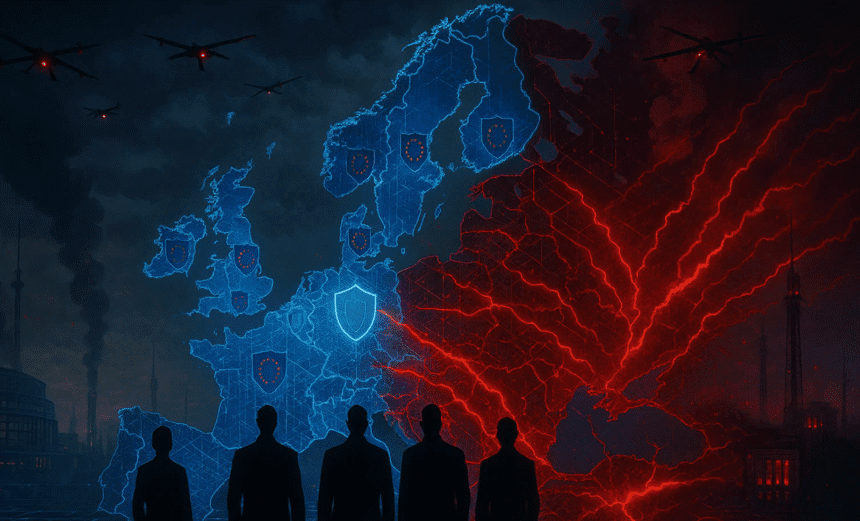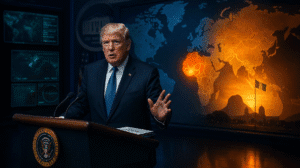The European Union has raised its security posture to the highest level of alert amid mounting evidence that Russia is waging a full-scale hybrid offensive aimed at undermining Europe’s democratic institutions. During a recent summit in Copenhagen and across key EU capitals, intelligence chiefs and political leaders warned that Moscow’s campaign has evolved far beyond conventional warfare in Ukraine; it now seeks to destabilize the European bloc itself through covert, coordinated, and escalating means.
Russia’s hybrid warfare strategy, honed since its 2022 invasion of Ukraine, has become an all-encompassing effort to corrode trust, sow political discord, and exploit vulnerabilities within Western democracies. European officials say that recent months have seen a surge in disinformation campaigns, cyberattacks against government and energy infrastructure, acts of sabotage, economic coercion, and an alarming series of drone incursions across NATO and EU borders. The ultimate objective, according to EU security analysts, is to weaken public confidence in democratic governance and erode the unity of Europe’s collective response to Moscow’s aggression.
Among the most visible threats are large-scale disinformation operations that target elections and political discourse. Russian-linked networks have been detected amplifying divisive narratives and conspiracy theories ahead of upcoming national votes in Germany, Romania, and across the EU. By exploiting social media and fringe media outlets, these actors aim to polarize societies and question the legitimacy of democratic outcomes. Parallel to this, a wave of sophisticated cyberattacks has targeted Europe’s critical infrastructure, including communications networks, transport systems, and power grids. Intelligence agencies attribute many of these strikes to Russia’s GRU military intelligence units and affiliated hackers, whose tactics are designed to create confusion without leaving clear fingerprints.
Another growing concern is the use of drones as tools of provocation and surveillance. In September 2025, a dramatic incident in Poland saw up to two dozen drones of suspected Russian origin penetrate Polish airspace, flying over Warsaw, Lublin, and Rzeszów before being intercepted by NATO forces. The event triggered the launch of Operation Eastern Sentry, a coordinated NATO response to reinforce air defense systems along Europe’s eastern flank. Similar drone incursions have since been reported over Germany, Belgium, and Denmark, prompting temporary airspace closures near airports and military sites. European defense officials now view such incursions as deliberate stress tests of NATO’s readiness and cohesion, part of a broader Russian effort to probe for weaknesses without crossing the line into open war.
The EU’s political response has been swift but cautious. In July 2025, the EU High Representative issued a formal statement condemning Russia’s “persistent hybrid campaigns” against member states, warning that such actions were designed to erode Europe’s political foundations. The European Parliament has since drafted a resolution urging closer coordination on cybersecurity, intelligence sharing, and hybrid defense through institutions like the European Centre of Excellence for Countering Hybrid Threats. Member states are also boosting their defense budgets, deploying anti-drone systems, and debating new laws that would authorize the immediate neutralization of unidentified drones over national territory. Some governments, meanwhile, are pushing to redirect frozen Russian assets to strengthen both Ukraine’s war effort and Europe’s internal resilience.
Despite these measures, analysts caution that Europe’s counter-strategy remains fragmented. While initiatives such as the proposed “drone wall”, a network of detection and neutralization systems along the EU’s eastern border, represent progress, they remain largely symbolic without deeper intelligence cooperation and shared enforcement mechanisms. Experts argue that the EU must move beyond a defensive posture to a deterrence-based strategy, one that imposes tangible costs on Russia’s hybrid operations, whether through sanctions, cyber counter-operations, or coordinated exposure of disinformation networks.
The broader risk, European security officials warn, lies not only in physical or digital attacks but in the corrosion of trust that sustains democratic life. If Moscow’s hybrid warfare continues unchecked, it could weaken public faith in institutions, polarize electorates, and fracture the unity that underpins the EU’s collective defense. The threat is thus existential, not of armies crossing borders, but of democracies being hollowed out from within. As one senior EU diplomat in Brussels put it, “This is a war without tanks, but its damage could be far greater.”
Europe’s hybrid battlefield now extends far beyond Ukraine. Every false headline, every hacked server, and every drone that crosses a border is part of a larger strategic campaign to test the resolve of Europe’s democracies. The EU faces a long and complex struggle, one that will require not only technology and intelligence but political solidarity and public awareness. In an era where disinformation can travel faster than diplomacy, defending democracy may prove to be Europe’s greatest test yet.
















